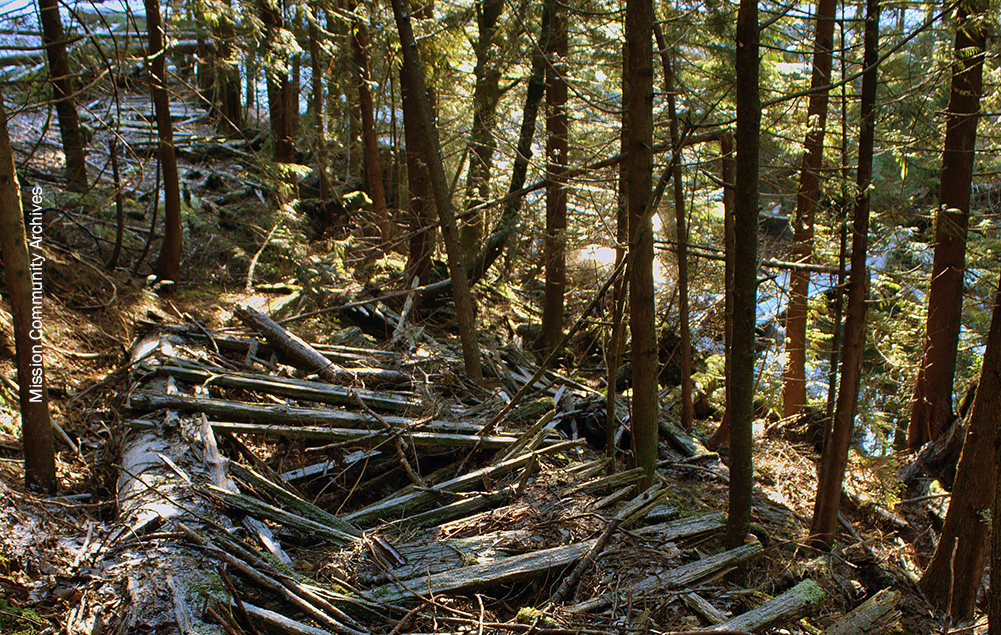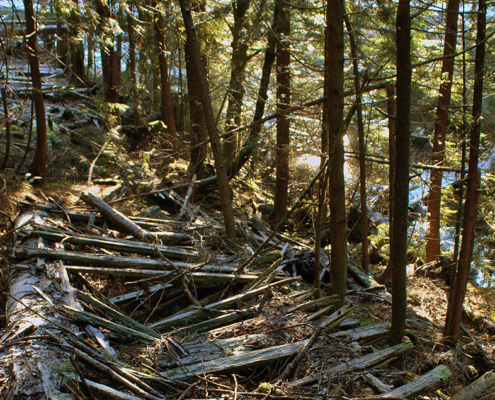Hoover Lake Corduroy Road
Location:
Hoover Lake Trail
Historic Neighbourhood:
Steelhead
Date of Original Construction:
1890 – 1955
Category:
Recreation
Status:
Province of British Columbia and City of Mission
Description:
Winding alongside the popular Hoover Lake Trail lies a historic Corduroy Road; a planked access way used for logging from the late 1800s up until the 1950s. It is approximately 0.7 kilometres in length and once allowed for the transportation of freshly fallen logs out of the forest and to nearby mills.
History:
Forestry has always been a major part of the economy in all Southwestern British Columbia, ever since the 1800s, when many parts of the province were first settled. Mission had an abundance of cedar, Douglas fir, and hemlock trees, all of which were prime timber species. Logging in the hills of northern Mission first began in the early 1900s, with numerous different companies investing in the area. A large block of untouched, quality timber was said to extend from the lower Stave River and eastward towards northern Mission,1 and it is within this area that the Hoover Lake Corduroy Road is located.
Despite the quality of the wood in this remote and mountainous terrain, it was still a challenge to transfer fallen logs from the site to the nearest mill or log dump, which was estimated to be at least four kilometers away. Prior to improvements in forestry transportation and modern machinery, the pioneers of early logging used much simpler practices to move harvested timber. They laid a pattern of cedar logs and planks along a cleared trail to create a smoother surface for hauling the fallen logs, thus founding the corduroy road.
Originally, oxen or draft horses were used to haul the logs along these planked access ways. This method continued into the early twentieth century, when the “steam donkey” was first introduced in the Pacific Northwest.2 This portable steam engine was invented by John Dolbeer in 1881 and was said to revolutionize the logging industry, allowing for logs to be hauled faster and more easily along the corduroy roads.3 One was found at the shore of Hoover Lake, since the road itself was originally built in the late 1800s or early 1900s.4 It was later reconstructed by subsequent license holders, with intermittent logging continuing over multiple decades up until the early 1950s, when the forest was re-planted.5
Walking through the Municipal Forest that covers the Hoover Lake area today, there is numerous evidence of past logging exploits. Before the chainsaw was invented in the late 1920s, loggers used a long-crosscut saw with handles at each end to cut the trees by hand. To cut them above the wide base of the tree trunk, springboards were notched into the wood for the loggers to stand on. These notches are still visible today in the old growth stumps that line the trail and fill the now peaceful forest.
People Associated with the Site:
Although the exact company responsible for the construction of the Hoover Lake Corduroy Road is unknown, there are many possible logging companies who operated in that area over the years. One of the earliest to own timber holdings east of the Stave River was Heaps Timber Co., a branch of E.H. Heaps & Company Ltd.6 However, by 1913 Heaps Timber Co. had apparently overextended itself and was taken over by Keystone Logging Company sometime between 1914 and 1915.7
Keystone Logging Company would proceed to log the main portion of the timber stand between Steelhead and Mission, primarily owned and operated by the main shareholder Henry George James. 8 It is this company after which Keystone Avenue was named, with the road originally being used for logging access between northern Mission and the Stave River.9 In 1919, the camp completely burned down caused by an engine spark.10
From about 1915 to the 1920s, many tie and shingle mills were established in the northern reaches of Mission. One of the earliest of these mills to be built was Pete Hammer’s in Steelhead, who homesteaded there in 1913, along with other names such as “Bowyers, Jack Harris, and Craig & Taylor.” 11 There is a possibility that the wood supplied to these mills came from the nearby Hoover Lake logging area. Lastly, the Osbourne Mill owned by Ted Osbourne operated in Steelhead around 1916. 12
Architectural Features:
Also known as a “skid road,” the corduroy roads were built by laying two parallel lines of large logs on the ground, in the same direction as the route. On top of this foundation, hand cut wooden planks were nailed perpendicularly across the logs and then greased to create a smooth, more workable surface. This pattern of patchwork wood resembled that of the fabric corduroy, thus giving the roads their nickname. One of the most useful characteristics of cedar wood, particularly western red cedar, is its high resistance to decay, making it ideal for long lasting roads. Furthermore, the logs were submerged in wet and acidic soils, so they tended to decay even slower, allowing for the well-preserved Corduroy Road to still be visible to hikers today.
Landscape:
The far reaches of northern Mission are a rugged and heavily forested landscape, made lush and green from rainfall, rivers, and creeks. The Hoover Lake Trail is located within the Steelhead Community, which is surrounded by low mountains. The forest is primarily composed of coniferous trees, with the most common being Douglas-fir, western hemlock, Western Red Cedar, and varieties of pine, among the occasional deciduous tree. Beneath the canopy of trees, the moss, lichen, ferns, and variety of wild bushes host an abundance of wildlife. Approximately four kilometres to the west lies Stave Lake, or the Stave River, as it was known before being dammed. From certain heights in Steelhead and the Hoover Lake area, views of northern snow-capped mountains such as Robie Reid and Judge Howay can be seen.
Additional Information
Footnotes:
-
- Arnold M. McCombs & Wilfrid W. Chittenden, The Fraser Valley Challenge: An Illustrated Account of Logging and Sawmilling in the Fraser Valley (Treeline Publishing, 1990) 60
- Clarke Historical Museum, “John Dolbeer’s Steam Donkey,” Clarke Museum, 2018,
- Ibid
- Kelly Kitsch (Cameron), email to Archivist Val Billesberger, June 2, 2020, Mission Community Archives
- Kelly Kitsch (Cameron), email to Archivist Val Billesberger, June 9, 2020, Mission Community Archives
- Arnold M. McCombs & Wilfrid W. Chittenden, 59
- Ibid
- Arnold M. McCombs & Wilfrid W. Chittenden, 60
- Ibid
- “James Camp Burned Down,” Fraser Valley Record (Mission) Oct. 2, 1919
- Arnold M. McCombs & Wilfrid W. Chittenden, 71
- Arnold M. McCombs & Wilfrid W. Chittenden, 70




